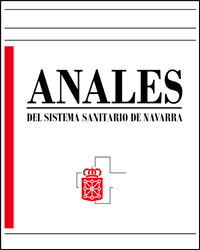Pulsioximetría fetal. Nuevo método de control fetal intraparto. Estudio comparativo con técnicas invasivas acerca del bienestar fetal
DOI:
https://doi.org/10.23938/ASSN.0472Palabras clave:
Pulsioximetría fetal. Equilibrio ácido-base. Hipoxemia. Resultados perinatales. Bienestar fetal intraparto.Resumen
Fundamento. La pulsioximetría, técnica que mide de forma continua la saturación de oxígeno en sangre (%SpO2), se ha convertido en un método de monitorización estándar en anestesia, cuidados intensivos, neonatología, etc., pudiendo llegar a ser útil a los obstetras en la monitorización del bienestar fetal durante el parto. Tiene la ventaja de ser mínimamente invasiva y fácil de usar. La saturación de hemoglobina fetal oxigenada es un buen parámetro para medir el contenido-déficit fetal de oxígeno. Una saturación menor del 30% durante un periodo de tiempo superior a 10 minutos se correlaciona con una pHmetría de micromuestra de cuero cabelludo fetal <7,20 y es predictivo de mal pronóstico neonatal. Los objetivos del presente trabajo son: 1. Observar si el uso combinado de las dos técnicas proporciona resultados perinatales equivalentes, disminuye la tasa de cesáreas intraparto debidas a sospecha de pérdida de bienestar fetal intraparto. 2. Establecer una correlación entre los valores de la saturación de oxígeno en sangre (pulsioximetría) y los valores de pH, pO2 y equilibrio ácido-base (EB) obtenidos por pHmetría. Material y métodos. Se han recogido datos de 2 grupos de 80 pacientes con gráfica insatisfactoria, comparables entre sí. En el primero se realizó el seguimiento del parto bajo pHmetría seriada, y en el otro grupo, los controles de los fetos se realizaron de forma conjunta con pHmetría y pulsioximetría. Resultados. Se obtuvieron resultados estadísticamente significativos en la vía del parto en el estudio comparativo de ambos grupos. Atendiendo a los resultados perinatales obtenidos, los datos indican que no existen diferencias significativas en los valores de pH de arteria umbilical ni en los valores del Apgar al minuto y a los 5 minutos del parto entre los dos grupos, por lo cual ambos protocolos son igualmente satisfactorios. La correlación de los datos obtenidos por pHmetría con los de la pulsioximetría, fue estadísticamente significativa. Conclusiones. El uso combinado de ambas técnicas aumenta la sensibilidad y especificidad del diagnóstico de riesgo de pérdida del bienestar fetal intraparto, sin afectar los resultados perinatales, reduciendo la tasa de cesáreas intraparto debidas a registro cardiotocográfico fetal patológico. Existe una correlación estadísticamente significativa entre los resultados obtenidos por el pulsioxímetro y la determinación del equilibrio ácido-base tanto de micromuestra sanguínea fetal del cuero cabelludo como de sangre de cordón umbilical.Descargas
Descargas
Publicado
Cómo citar
Número
Sección
Licencia
La revista Anales del Sistema Sanitario de Navarra es publicada por el Departamento de Salud del Gobierno de Navarra (España), quien conserva los derechos patrimoniales (copyright ) sobre el artículo publicado y favorece y permite la difusión del mismo bajo licencia Creative Commons Reconocimiento-CompartirIgual 4.0 Internacional (CC BY-SA 4.0). Esta licencia permite copiar, usar, difundir, transmitir y exponer públicamente el artículo, siempre que siempre que se cite la autoría y la publicación inicial en Anales del Sistema Sanitario de Navarra, y se distinga la existencia de esta licencia de uso.








